Plumbing an inground pool is actually easier than it sounds — as long as you have a detailed plan and work carefully. The last thing you want after laying inground pool plumbing is to discover an underground leak!
Most of our DIY inground pool kit customers do their own plumbing, or will have a worker do it for them; there’s no need to hire a professional plumber. Before we get into some detail about how to plumb an inground pool, let’s define the what, where and when of inground pool plumbing.
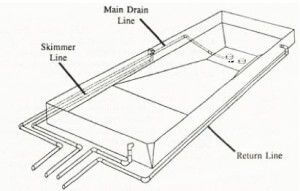
Pool plumbing are the buried pipes underground, connecting the pool with the filter equipment. The suction lines, skimmer and main drain, are two pipes that connect into the pool pump, via a 3-way valve. The return line is the pipe that carries water from the pool filter, back to the wall return inlets. Other plumbing lines may be connected to step jets, a pool cleaner line, or fountains and water features. Pool plumbing is done after the pool walls are erected, about halfway through the process.
Materials for Inground Pool Plumbing
First, measure from your equipment pad to the skimmer, main drain, returns and any other plumbing lines. Your suction pipes (skimmer, main drain) typically come up on one side of the equipment pad, and the return pipes come out of the ground on the other side of the pad.
Inground Pool Kits
All-in-one pool kits come with all you need to install an inground pool. But if your pad is located far from the pool, or if you add a cleaner or fountain line, you’ll need more pipe, PVC fittings and valves.
- 100′ – 1.5″ Sch 40 Flex pipe
- 4 – 1.5″ Tee fittings
- 5 – 1.5″ 90 fittings
- 4- 1.5″ Couplings
- 2 – 1.5″ Unions
- 4 – 1.5″ Male adapters
- 2 – 1.5″ 3-way valves
- 4 – 1.5″ Street elbow
- 1 Qt Ultra Grip Blue
- 1 Qt Purple Primer
- Teflon Tape
When you measure your plumbing runs, do not forget to add the vertical amount of pipe needed, and the pipe, fittings and valves needed above ground, to connect the pool plumbing to the pool equipment.
You will also need a measuring tape, a power saw, and sandpaper to smooth off edges after cutting.
Other supplies that you’ll need include a measuring tape, a power saw, either reciprocating or jig saw, with a few sharp blades. Emory cloth or sandpaper can be used to smooth off the burrs after cutting the pipe. Teflon tape and silicone is used for threaded fittings. I like to have a on hand, to quickly wipe up any glue that may ooze out, and run down the pipe – keeps it looking neater.
Differences in Sch 20, Sch 40 and Sch 80
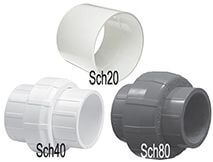
This refers to the thickness of the pipe wall. Sch stands for Schedule. A pipe labeled Schedule 20 will have a thickness of 0.100″, and a Sch 40 pipe will have a 0.150″ wall thickness. Schedule 80 pipe is a gray PVC, with a 0.200 wall. Sch 80 fittings can be used on pumps and filters, if you encounter a problem with Sch 40 fittings melting and shrinking, and leaking. Sch 20 pipe should not be used on pool plumbing, or pressurized lines, Schedule 40 is standard.
6 commonly used PVC fittings

- Coupling – Used for joining two sections of pipe.
- 90 – An elbow fitting, turns the pipe 90 degrees.
- 45 – A half-elbow, turns the pipe 45 degrees.
- MTA – Male threaded adapter, Male threads x Slip
- FTA – Female threaded adapter, Female threads x Slip
- Tee – 3-way fitting, 1 pipe coming in, two going out.
Plumbing Your Pool Light Conduit
For the conduit that is used to carry power wires to the pool light, you’ll need a quantity of 3/4″ gray conduit, which you can buy in 10′ lengths. They have couplings built into the ends, but you may need to buy a few 90 or 45 fittings. Conduit can be heated up and bent gently with a small blow torch, to go around gentle turns.
Your conduit will need to be run from the pool junction box to the pool light niche, which mounts on the wall of the pool. The junction box may be located at the equipment pad, if that is close to the pool light, or a j-box can be mounted closer to the pool light, to meet the 50′ pool light cord. The j-box can’t be closer than 10 feet from the pool, and must be 18″ above the water level in the pool, as shown in this image.
Run your conduit from the pool light niche, to the junction box, which is where the pool light cord meets the power cord from the breaker box, which also needs to be encapsulated in electrical conduit, rigid or flexible.
Backfill the Trenches
I like to wait to backfill the trenches until we have the pool pump and filter operating; that’s my method of pressure testing. The liner goes in and the pool is filled. Then we install the faceplates and flood the lines. Let the system run for a day, and if you do not see any wet spots on dry soil, then we’re ready to backfill around the pool, and in the pipe trenches. Fill and compact the soil gently so that you do not put pressure on underground pipes and fittings. Water-in the soil around pipes, to be sure dirt gets underneath, for support.
Tips for Making a Glue Joint
- Make straight cuts across the pipe.
- Remove rough edges or burrs on pipe.
- Use primer on pipe and fitting before gluing.
- Apply a liberal amount of fresh glue to pipe and fitting.
- Use only deep socket pressure fittings, Sch 40
- Push together and hold firm for 20 seconds after gluing.
How to Plumb an Inground Pool
Continuing our series of how to build an inground pool, we now reach the phase of plumbing your pool, to connect the pool suction and return fittings to the filter and pump system. At this stage, the pool is dug, the walls are erected, and the pump and filter system are in place, on a level slab of concrete or pressure treated wood.
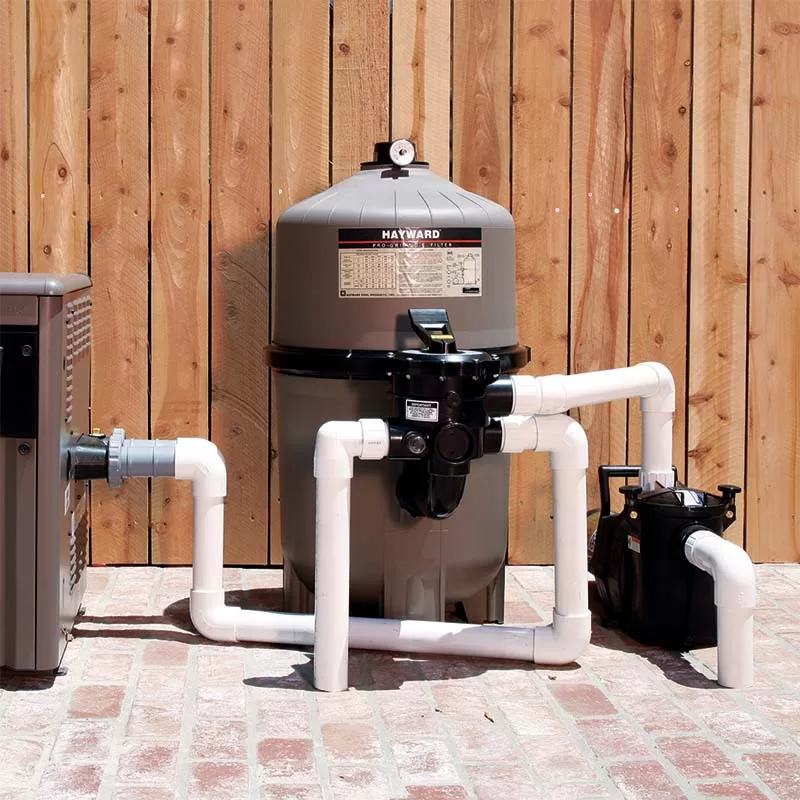
There are different types of piping that can be used for plumbing an inground pool. Most popular is schedule 40 PVC pipe. Schedule 40 pipe is available in rolls of flexible PVC or as rigid sticks, either 10 or 20 feet in length. Black Poly pipe, also sold in rolls, can be used. Black poly pipe will use barbed fitting inserts and clamps to connect to the pool and equipment, rather than glued PVC fittings.
The most commonly used pipe for inground pool construction is the 100 ft roll of flexible PVC pipe (1.5″ diameter). Having a continuous roll makes it easier to wrap around corners and you will need fewer connectors. If you purchased your inground pool kit from In The Swim, the Deluxe or Deluxe Plus pool kits come with everything you need to plumb the pool.
Pipe & Fittings Kit includes:
- Schedule 40 Flex Hose 1-1/2″ x 100′ (1)
- PVC White Tee 1-1/2″ (4)
- Male Adapter 1-1/2″ (4)
- PVC White 90-degree Elbow 1-1/2″ (5)
- PVC White Coupling 1-1/2″ (4)
- 1-1/2″ PVC 90 degree Street Elbow (4)
- 1-1/2″ PVC 90 degree Street Elbow (4)
- 1 Quart Ultra Grip Blue Cement
- 1 Quart Purple Primer
Also included in our DIY inground pool kits – two 1-1/2″, 3-way Jandy valves and the Hayward Pool Plumbing Pack (widemouth Skimmer, extension collar, vacuum plate, 2 Returns, 2 VGB Main Drains).
Plumbing the Main Drains:
New main drain safety laws require the use of dual main drains, to prevent entrapment on a single main drain. Dig a small hole in the bottom center of the floor, and place the 2 main drains, 3 ft apart from each other. Run a bit of pipe between the 2 drains with a Tee fitting in the middle of the pipe. From the Tee, connect a pipe that will run through the deep end slope, up underneath the wall. Once outside of the wall, run this pipe all the way back towards the filter pump. Connecting your main drain pipe into the skimmer is not recommended; this method won’t allow you to adjust the suction of the main drain and skimmers independently.
Plumbing the Skimmer:
Connect the Hayward wide mouth skimmer to the wall panel with the cut-out. Connect a pipe to the rear hole of the skimmer, leave the front hole plugged. Use Teflon tape and silicone sealant on the fitting, and tighten securely, but don’t over-tighten as you risk cracking the skimmer body. Connect the pipe to the fitting at the skimmer bottom, and run this pipe back to the filter pump.
There are 2″ holes at the bottom of each skimmer. Use Teflon tape and a little pipe dope or silicone to prevent leaking. In the other hole of the skimmer, thread in a pvc pipe connector and glue your skimmer pipe into the fitting.
The next step is to connect the skimmer line and the main drain line into the pump. Install an MTA (male threaded adapter) fitting into the front port of the pool pump. Use a proper thread sealant so there won’t be any air leaks. Once the MTA is installed, glue a 6-12″ piece of rigid PVC pipe, into the fitting. Glue the other end into the port labeled “Inlet”, on one of your 3-way Jandy Valves. One the other two side ports, glue in the 1-1/2″ Street Elbows, with the opening pointing down to the ground. Finally, connect your pipe from the skimmer and main drain into these two Street Elbows.
If you want to use rigid PVC on the plumbing, cut the flexible pipe at the bottom of the trench and glue it into a SlipxSlip elbow fitting which points up toward the street elbow you glued into the Jandy Valve. In between these two elbow fittings, use a piece of rigid, schedule 40 PVC. Lengths of rigid PVC can be purchased at any home store, or plumbing supply house.
Plumbing the Returns:
The 24″ sand filter that is included in our Deluxe inground pool kits will have a multiport valve that mounts on the top of the filter tank. This valve has 3 ports, one labeled Pump – connect a pipe from the pool pump into this port, and one labeled Return – connect a pipe from this port towards the port labeled “Inlet”, on your other 3-way Jandy Valve. Using rigid pipe for these connections will look better, but is not required.
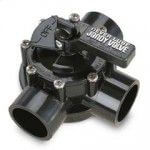
Coming out of the 3-way Jandy Valve, at 3 o’clock and 9 o’clock, you will again glue in two Street Elbows, pointing straight down to the ground. Glue two equal lengths of rigid PVC into these Street Elbows, and on the other end, into two slip elbows. Then glue your flex pipe into the other side of the elbows, and run your pipe to where the two returns are located, typically on opposite sides or ends of the pool. From your filter system, choose the shortest route around the pool, to reach the wall returns.
If you have more than two returns or two suction lines, you can add another valve, either a ball valve or a Jandy Valve, onto the return or suction-side manifold. Using a valve is important on each line, so that you have the most control over where and how your water flows.
Plumbing a Pool Heater:
If you have a pool heater you would do the return side plumbing a little differently. We will plumb the return side the same way, except that coming out of the multiport valve port labeled “Return”, we first run the pipe in and out of the heater. From your filter to your heater (or heat pump) and then out of the heater to your return side Jandy Valve, where the water splits into the two separate return lines going back – “returning” to the pool.
Plumbing Other Pool Equipment:
Our Deluxe pool packages include an Off-line chemical feeder. To install this you only need to drill 2 small holes in the return pipe. If you are installing a saltwater chlorine system or an In-line chemical feeder – you would install these after the filter, and after any pool heater, on the return line – before the return side Jandy Valve.
If you add any water features such as a waterfall, or deck jets, or equipment like a slide or a pressure-side (return-side) pool cleaner – these will be fed water from the return side as well. Typically, a tee fitting is installed on the return line, with a valve below the tee fitting, to control how much water is delivered or pumped to the device. Alternatively, instead of a tee fitting and a 2-way valve, you can install another 3-way Jandy Valve to control the amount of water delivered to other equipment.
Plumbing with Black Poly Pipe:
Black Polyethylene pipe can be purchased in long rolls, and is joined together using barbed PVC insert fittings, which are secured by stainless steel clamps around the pipe. Before inserting the fitting, apply pipe dope to the barbed fitting and insert the fitting deep into the pipe. Double clamp the pipe over the fitting with two clamps going in opposite directions. Tighten securely with a nut driver, then heat the pipe slightly with a torch. While still hot, tighten again on the clamps to improve the seal.
Black Poly pipe is not glued together like PVC pipe. Because of this, the joints are more likely to cause leaking problems years down the road. This is why some builders scoff and scorn at the idea of using Black Poly pipe. If however, you decide to use Black Poly, try to use as few underground connector fittings as possible, to reduce this possibility. The advantage of Black Poly pipe is that it can be purchased more cheaply than PVC pipe. This can save a few hundred dollars on large pool installations.
As described above, some DIY inground pool builders will use Black Poly underground, up until the equipment pad, and then come up out of the ground with rigid schedule 40 PVC, for a more secure and professional looking filter system installation.
Pressure Testing your Pool Plumbing:
If you want to be sure that your pool plumbing job was done well, without leaks – before backfilling over the pipes, you can pressure test the plumbing. This is done after all plumbing connections are complete, including the filter system plumbing. Allow the glue to cure for 24 hours.
Builders will usually have a homemade PVC pressure testing stick with a gauge. This is connected to the skimmer, and then all the other ports (main drains, returns, etc) are plugged at the pool using rubber expansion plugs. An easier method than building a pressure stick is to buy a Drain King. Available at most home stores, you connect this to a garden hose, and push it into the skimmer. Plug both drains and returns, open all valves. Open the air bleeder on the filter to allow the air to escape. Turn on the garden hose and the plumbing will fill up with water. Carefully check the entire run of plumbing for any leakage. It should be water tight, not even a drop should be discovered. Congratulations, now you can backfill over the pipe and up against the walls.
3-Way Valve
PVC Union
Check Valve
Our inground pool kits come with a starter plumbing kit. We give you valves, unions, assorted schedule 40 PVC fittings and 100 ft of schedule 40 flex pipe. In some cases you will need additional pipe, depending on the size of the pool, how many returns and skimmers, and any other water features you are planning, and the distance to the pool equipment. Extra pipe can be ordered at the time of the pool kit purchase and delivered along with the kit, or you can get extra pipe locally, either flex or rigid PVC.
Flex or Rigid PVC Pipe?
Flex pipe is much easier to work with; it lays flat in the trenches and makes turns without using flow restricting fittings. It also compacts in the soil more fully, and is less likely to break under compaction. Rigid PVC pipe is stronger against chemical degradation and resists problems from earwigs in the soil.
Many of our customers use rigid PVC where the pipe comes up out of the ground, and use flex pipe for the underground plumbing. Connecting the equipment with rigid PVC above the ground, looks neater, and makes the equipment less likely to move.
1.5″ or 2″ PVC Plumbing?
If you are upgrading to a Variable speed pump and filter with 2″ ports, it is a good idea to increase the pipe size to 2″ instead of the standard 1.5″ pipe. Variable speed pumps need 2 inch pipe to give a better flow and most cost savings – which is why you are purchasing the variable speed pump. Large water features, or powerful spa jets are another area where 2″ pipe may be used.
Pool Plumbing Trench
Have the operator dig a trench from the pool to where your pool equipment will be (your equipment pad). This will save you from hand digging a pool plumbing trench after the machine leaves your yard. Make sure it is at least about 2 ft wide and at least 2 ft deep. This will ensure enough room to fit all your pool plumbing lines and electrical conduit also.
How Deep Should Pool Plumbing Pipes be Buried?
Your plumbing lines should be about 2 ft underground to protect them from surface soil slip and shift and from freezing temperatures. If your pool is in the southern U.S., with rare freezing temperatures, you can bury your pool pipes a bit shallower, but if you can go deeper, it’s always a good idea. And, do not forget to call your local Dig Safe service, to have your utility lines marked (for free), before beginning any digging in your backyard.
If you’re in a cold weather climate, you will need to winterize your lines and equipment before freezing temperatures hit. This is done by blowing the lines and equipment out with a small compressor or blower vac. After the lines are cleared of water, the returns and skimmers are plugged at the pool, to keep water from re-entering the pipes during the winter.
Plumbing your Equipment Pad
- Space out your equipment for airflow and serviceability.
- All pipes coming out of the ground should have the same height.
- Use as few 90s as possible, to reduce resistance.
- Allow some room for future expansion.
- You can run a pipe for future use, capped off at the pad.
- Route your plumbing away from your electrical panel.
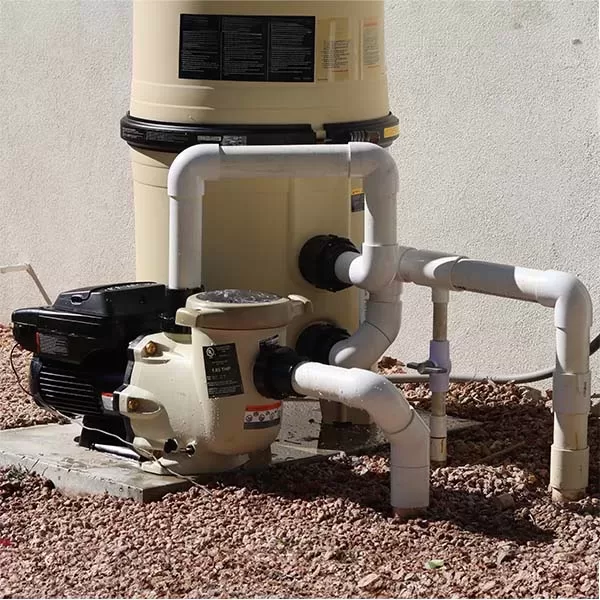
Your equipment pad is preferably a steel reinforced concrete slab, but heavy duty HVAC skids, set on a 4″ gravel base can also be used. Set your pump, filter, heater, etc., on your equipment pad in a logical order, leaving lots of room for future repairs or service. Also keep in mind any codes that may exist for placement. Heaters or heat pumps have special installation requirements.
Now that you have all your lines run from the pool to the pad it is time to start connecting to your equipment. Let’s start with the pump. In the front of the pump install a PVC union (not shown), and from that connect a short piece of pipe into a 3 way Jandy valve. Unions are useful for removing the pool pump easily for service or indoor winter storage.
Clean and glue your main drain pipe into 1 side of the valve and your skimmer to the other side of the valve. After the pump install a union, and then plumb to the inlet of your pool filter. If you have any other accessories that is where you pipe to next from the filter after putting in a union and then pipe to either a heater, heat pump, salt system or anything else then from there to a Jandy 3-way valve. In one side of the valve goes your step jets and in the other side goes your return fittings.
Pool Plumbing Techniques
When gluing PVC pool pipe into couplings, unions, valves or other fittings or connectors, the proper way is to clean the inside of the fitting and the outside of pipe, get it good and clean with a PVC primer. A good rule of thumb is clean it until you no longer see any writing (or dirt), so you know its clean. Within 15 seconds of cleaning, apply a liberal coating of fresh PVC glue on the inside of the fitting and the outside of the pipe. Push the pipe fully into the fitting with a small turning twist, and hold it for 30 seconds before releasing.
Threaded fittings require extra care to prevent cracks and leakage. Use 3-4 wraps of Teflon tape, in a clockwise direction around threaded male fittings. For extra security, first spread a thin layer of silicone or pipe dope over the threads, before wrapping with Teflon tape. When tightening threaded fittings into pumps, filters, heaters, chlorinators… be careful not to over-tighten, but turn only 1-2 turns beyond hand tight.
Pool Plumbing Tips
- Make a plumbing diagram, measure twice – cut once, and dry fit everything together first, before gluing your pipes and fittings.
- Use as few 90’s and 45’s as possible, to keep total system resistance as low as possible. Remove unnecessary turns in the plumbing.
- Support above ground pipes and allow enough room for equipment services and repairs.
- Leave at least 6″ of clear straight pipe on both sides of any piece of installed equipment.
- Plumb in order, from Pump to Filter to Heater to Chlorinator or Salt System.
- Avoid plumbing loops where freezing water may become trapped.
- Make straight pipe cuts with a sharp hacksaw, or reciprocating saw.
- De-burr the pipe after cutting, using rough sandpaper.
- Clean the pipe and fitting immediately before gluing with PVC pipe cleaner.
- Apply PVC glue liberally to both fitting and pipe, and quickly join, with a twisting motion.
- Hold the joint together for 10-15 seconds before releasing.
- With a wet cloth, wipe off any excess glue.
- Use a layer of silicone (I like Blue RTV) on threaded fittings, then 3 layers of Teflon tape, wrapped over the threads in a clockwise direction.
- Don’t over-tighten threaded fittings into pump, valve, skimmers, drains. Hand tight, plus 1-1/2 turns with large pliers.
Future Piping Plans
If you know when you install your pool that down the road you may want to add some water features, or an automatic pool cleaner, it is a good idea to run the underground piping when you install your inground pool kit. Unused pipes can just “stub-up”, out of the ground at the equipment pad, and be capped off above ground level for fountains, or connected through the pool wall with a wall return fitting.
At the filter end these would tie in on the filter side or return side of the equipment, you can just stub it up there and cap it also. Any water features should have their own valve to turn them on and off, you could install it now on the return side of the equipment, stub a piece of PVC out of it and glue on a cap at the end and when you do install your waterfall or whatever the water feature – you’ll be ready to go.
If you have any questions about inground pool kit plumbing, or run into any troubles while plumbing your inground pool, give our pool plumbers a call here at In The Swim – we’re here to help!
I hope that this little article about how to plumb and pressure test a swimming pool has been helpful and informative. Pool plumbing is not hard to do, just be sure to plan each section of pipes and fittings. Thousands of homeowners just like you have figured out how to build an inground pool, from pool guys like me. Plumbing an inground pool is one of the fun parts of building your own inground pool – enjoy it.

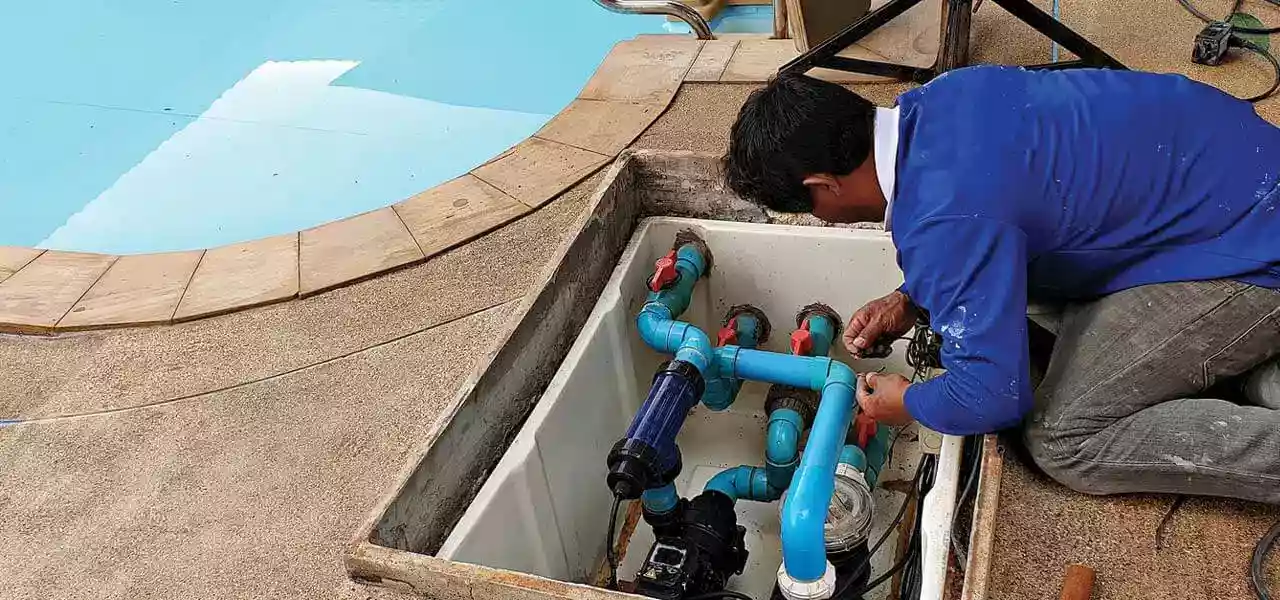

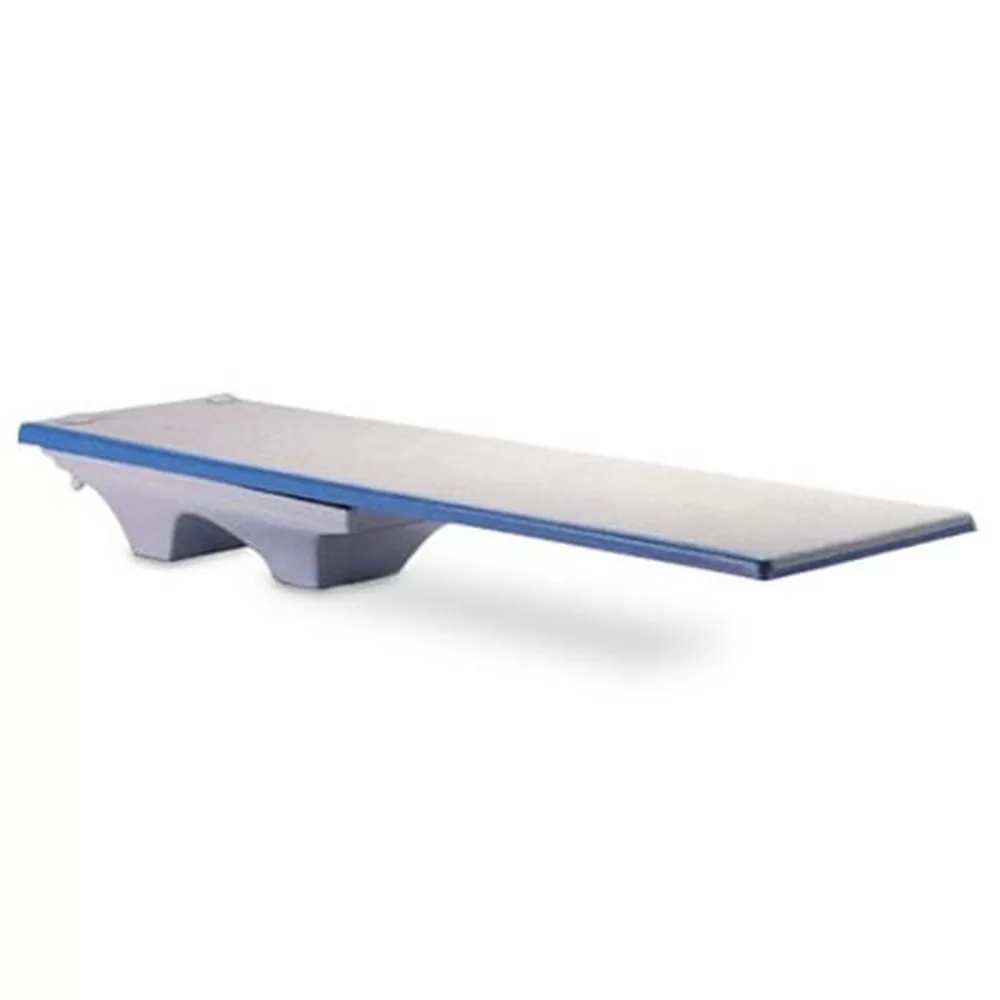
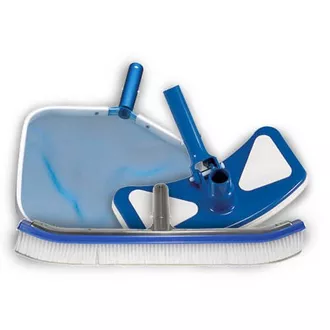
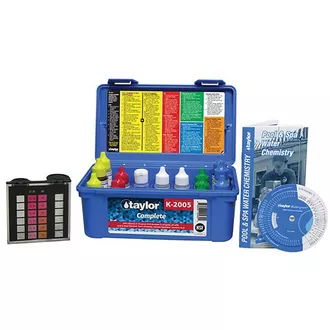




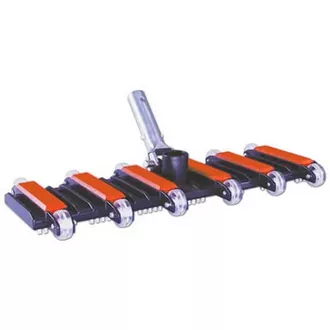
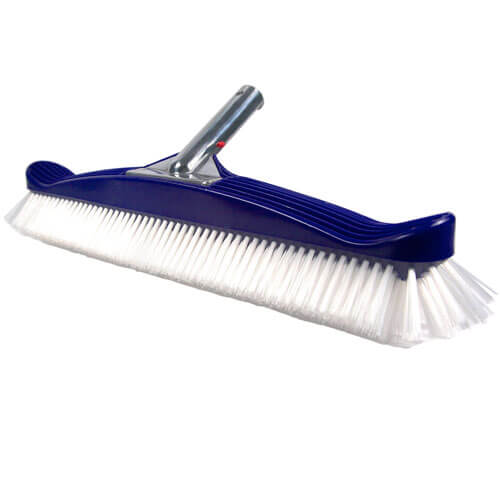
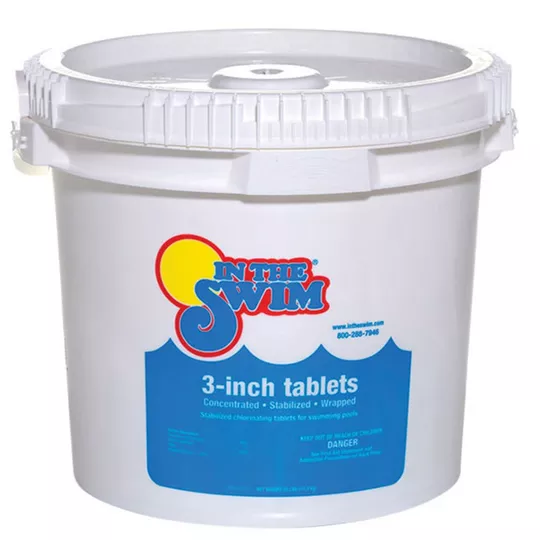
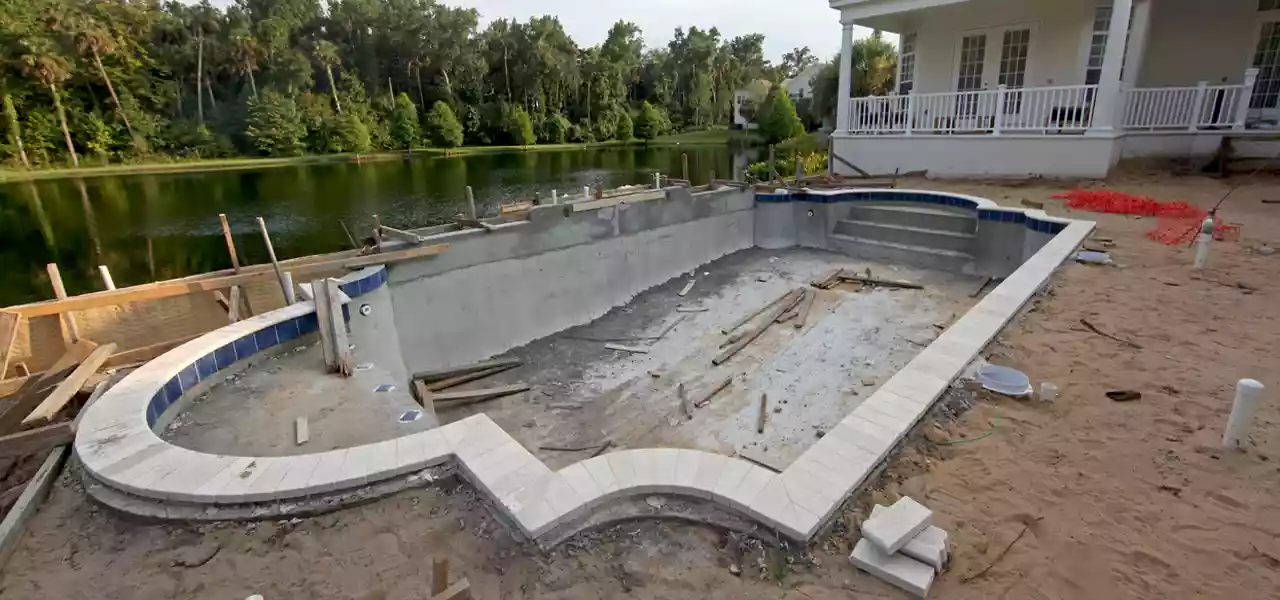
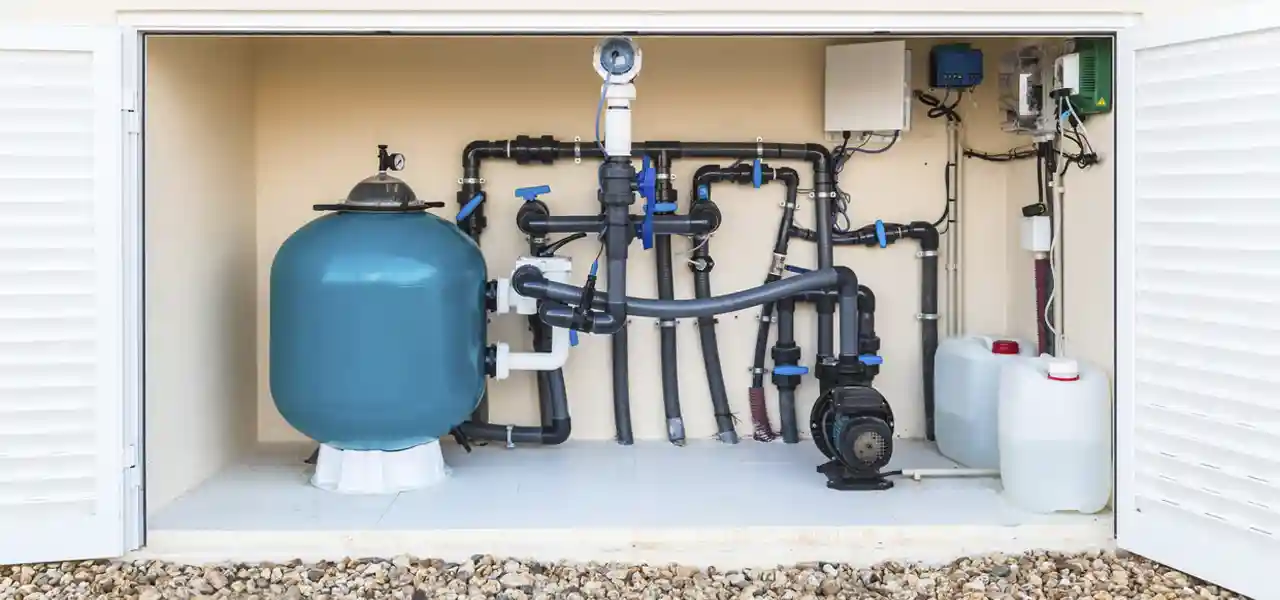
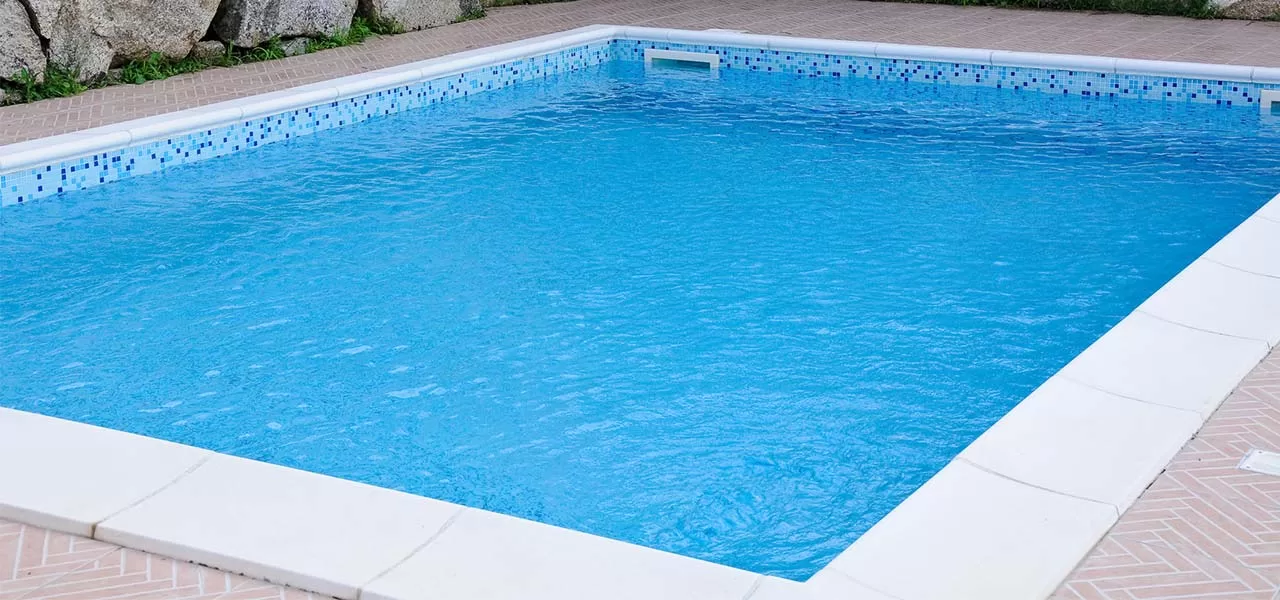
good
Hi Davy, im planning on replacing my pump and relocating my filter to a varible speed pump and cartridge filter 4 or 5 feet away from pump. Is there a maximum recommended distance between the pump and filter? Can the outlet from the pump go back under ground and back up to the filter on the other side of a walkway?
Hi Eric, yes you can do as you say, place them apart and run the pipe between under the sidewalk. Use sweep elbows for lower resistance.
I am going to install a lion head wall fountain so that a stream of water “spits” from the lion’s mouth. What diameter of tubing should I use to deliver this water so that the stream is steady? I don’t want it to dribble out nor do I want it to shoot across the pool. What is the standard size tubing for such a project?
Hi Maurice, you will install a valve on the line, so that you can control the ‘throw’, or the length and size of the stream. In most cases, you will use 1.5″ PVC pipe, all the way up to behind the wall, then go thru the wall in a conduit, with 3/8″ heavy plastic tubing. Put the valve on the 1.5″ PVC, and reduce down in size to a 3/8″ hose adapter, clamped securely. You can put the valve back by the equipment, or right behind the wall, whatever is more convenient.
I will have 2 skimmers. Is it ok to use 2″ pipe to supply pump and 1 1/2″ to returns? Thanks.
It’s OKAY… but it would be better to use 2″ to the pool, as far as possible, and at least all 2″ above ground, between pump and filter and to the return line. Using 1.5″ will result in a little higher pressure and slower flowrate, and increased workload/cost to run the pump.
Should I connect Polaris booster pump to main return pipe or pipe it separately (inlet & outlet)?Thanks.
The booster pump should draw inlet water from the pool return line (after any heater but before chlorinator), and discharge the water to a dedicated return line, 1.5″ in size.
Should the return lines be above or below the water
Hi Ralph, place your return lines below the water level, about 9″ or so, and use a threaded coupling flush with the pool wall, 1.5″ PVC Sch 40, so that you can thread-in a standard eyeball fitting. Also orientate them so that a circular flow pattern is created, around the pool. You may however, want to install one or two spray heads above the water level, to aerate the water, and cool the water, or just for the sound and look of fountain spray heads just above the water level.
Hi,. Do i have to install the 2 main drains on a flat bottom 52″ pool. It’s only 10x 18 in ground.
John, having a main drain will help with circulation and water clarity, and cleanliness, but is not absolutely necessary in a pool only 52″ deep, and with such small dimensions.
Do I need a bottom drain in my pool?
Not having a bottom drain can be circumvented by having some wall returns that can sweep water across deeper sections, or by running a pool cleaner on a daily basis, especially robotic cleaners that also filter the water, but the circulation from any cleaner is helpful. Another trick is to set up a pool vac head and hose and connect to skimmer, and keep it set up in the deep end of the pool for a few hours after vacuuming, to help. Brushing the pool twice weekly can help compensate. Clarifiers can also help. So yes, it is very desirable to have a main drain, for the best circulation and not just one, but dual main drains are now required. And very large or long pools can benefit from a secondary set of drains.
I am installing my own 16’x32′ inground pool. I want to locate pumps and filter 60’away from pool.I am thinking of a 2HP motor. Will this work?
Hi Giles, 60 ft away is no problem. You probably dont need a 2hp pump for that purpose. It can be a big problem if you put on a pump that is too large for the filter. Check the filter design flow rate, usually on the filter label, and then check the flow chart curve of the pump you like, and select a pump that will produce less than the design flow rate maximum, based on an estimate of your overall resistance rating, in feet of head (vertical axis of the pump flow curves)
I am new inground pool owner and have a new pool pump that I am installing that takes a 2” intake and output connection but I have existing 1.5” pipe throughout. Would a 1.5” to 2” adapter work to go from the 2” coming in/out of the pump to get it to the existing 1.5 pipe?
Hi Pete, there are many ways to reduce it, you could do it right at the pump using threaded reducing bushings 2″ x 1.5″, or you can go with 2″ connected to the pump, and reduce it as you connect to the filter. The easiest way is to do it at the pump I suppose.
I want to reroute the electrical feed to the pump on an in ground pool. Can I use thin wall conduit, and also use a receptacle to plug and unplug the pump for service?
Hi Bob, most pumps are connected with flexible conduit, and per code must be attached with conduit connectors, so that everything is water tight. Code may also prohibit plugging-in (or using 110V) on an inground pool, but I’m not certain about that. If your motor is reversible (check motor label for hi/lo voltage wiring instructions), then you could switch voltage to 110V, and connect a 3-wire grounded NEMA style plug, 12-14 gauge wire, and plug it into a GFCI outlet. For safety, you could run the cable in some rigid conduit and use a cable clamp 3/4″ on the motor. See this link for more info: http://www.brockportny.org/files/building-code/Electrical-WIRING-SWIMMING-POOLS.pdf
I am about to start a 18x43x30 True L pool. I am going to have 2 main drains and 2 or 3 skimmers and 4 returns. I am going to use a 2.7 hp VS pump. I was planning on running separate 2″ lines on the pair of main drains and each skimmer. Also going to use 2″ for the returns…should I run separate lines for each, or put 2 on one and 2 on another run?
Hi Robert, there is no need to run separate lines for returns, as you can balance them at the wall, using different sized eyeball fittings. Use larger eyes (3/4 or 1″) further away from the pump, and use smaller (3/8 or 1/2) eyeballs on the returns closer to the pump.
My pool is not working. Water from skimmer is not flowing into basket. Motor is working , valve is open! I do not know who to call to fix what may be a blockage in the pipe. Pool company I called basically just did an inspection and used a drain king to no avail.
Hi Ruth, the Drain King is a great tool for unclogging pipes, and also useful for pressurizing lines to find out where an air leak is exactly. So, you either have a big air leak, somewhere before the impeller, or the skimmer has a debris clog, or a plug fell down the pipe, or flexible pvc was used, and now a section of the pipe has collapsed. Most air leaks come from the threaded PVC fitting that screws into the pump, which can be patched quickly with Pool Putty, or the fitting can be replaced. Second most common is a loose pump lid, or dirty and unlubed lid o-ring. Third would be pump drain plugs or leaky valves for the skimmer/main drain lines. Clogs are most easily cleared with a Drain King, or a snake. And for the collapsed line, if flex pipe was used underground near the skimmer, we wrote a blog post https://blog.intheswim.com/sylvan-pool-flex-pipe-skimmer-repair/. Boost up the chlorine, and lower the pH, hopefully you can still run the filter from the main drain? You could run an emergency temporary, above ground pipe from the pool to the filter if need be, and not too far of a run.
I had my pool repiped last year and they tied my main drain into a waterfall line which has a separate pump .When I blow out the main drain from the pool pump 3 way valve I have to close the valve to the water fall pump to blow out the line. why would it be piped that way?
Hi Joe, sounds like they connected the two pipes underground, or put another way, both the filter pump and waterfall pump share the same single main drain pipe? This was a more economical method, rather than running a separate, dedicated pipe for the waterfall pump, which may be rarely used? Perhaps there is a controller that will automatically turn the valves, so that both pumps are not trying to pull water from the main drain, at the same time?
Good